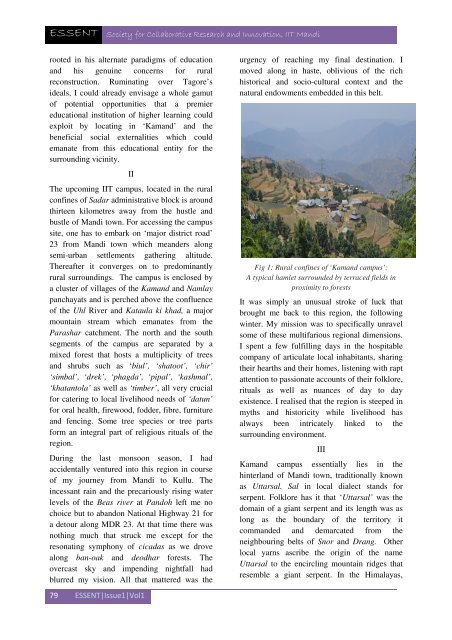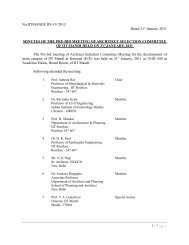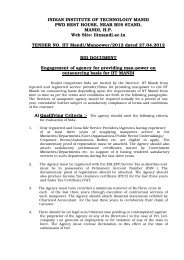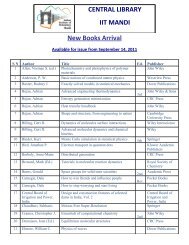Issue1. Vol.1 (April, 2013) - IIT Mandi
Issue1. Vol.1 (April, 2013) - IIT Mandi
Issue1. Vol.1 (April, 2013) - IIT Mandi
- No tags were found...
You also want an ePaper? Increase the reach of your titles
YUMPU automatically turns print PDFs into web optimized ePapers that Google loves.
ESSENT Society for Collaborative Research and Innovation, <strong>IIT</strong> <strong>Mandi</strong>rooted in his alternate paradigms of educationand his genuine concerns for ruralreconstruction. Ruminating over Tagore’sideals, I could already envisage a whole gamutof potential opportunities that a premiereducational institution of higher learning couldexploit by locating in ‘Kamand’ and thebeneficial social externalities which couldemanate from this educational entity for thesurrounding vicinity.<strong>IIT</strong>he upcoming <strong>IIT</strong> campus, located in the ruralconfines of Sadar administrative block is aroundthirteen kilometres away from the hustle andbustle of <strong>Mandi</strong> town. For accessing the campussite, one has to embark on ‘major district road’23 from <strong>Mandi</strong> town which meanders alongsemi-urban settlements gathering altitude.Thereafter it converges on to predominantlyrural surroundings. The campus is enclosed bya cluster of villages of the Kamand and Namlaypanchayats and is perched above the confluenceof the Uhl River and Kataula ki khad, a majormountain stream which emanates from theParashar catchment. The north and the southsegments of the campus are separated by amixed forest that hosts a multiplicity of treesand shrubs such as ‘biul’, ‘shatoot’, ‘chir’‘simbal’, ‘drek’, ‘phagda’, ‘pipal’, ‘kashmal’,‘khatantola’ as well as ‘timber’, all very crucialfor catering to local livelihood needs of ‘datun’for oral health, firewood, fodder, fibre, furnitureand fencing. Some tree species or tree partsform an integral part of religious rituals of theregion.During the last monsoon season, I hadaccidentally ventured into this region in courseof my journey from <strong>Mandi</strong> to Kullu. Theincessant rain and the precariously rising waterlevels of the Beas river at Pandoh left me nochoice but to abandon National Highway 21 fora detour along MDR 23. At that time there wasnothing much that struck me except for theresonating symphony of cicadas as we drovealong ban-oak and deodhar forests. Theovercast sky and impending nightfall hadblurred my vision. All that mattered was the79 ESSENT|Issue1|Vol1urgency of reaching my final destination. Imoved along in haste, oblivious of the richhistorical and socio-cultural context and thenatural endowments embedded in this belt.Fig 1: Rural confines of ‘Kamand campus’:A typical hamlet surrounded by terraced fields inproximity to forestsIt was simply an unusual stroke of luck thatbrought me back to this region, the followingwinter. My mission was to specifically unravelsome of these multifarious regional dimensions.I spent a few fulfilling days in the hospitablecompany of articulate local inhabitants, sharingtheir hearths and their homes, listening with raptattention to passionate accounts of their folklore,rituals as well as nuances of day to dayexistence. I realised that the region is steeped inmyths and historicity while livelihood hasalways been intricately linked to thesurrounding environment.IIIKamand campus essentially lies in thehinterland of <strong>Mandi</strong> town, traditionally knownas Uttarsal. Sal in local dialect stands forserpent. Folklore has it that ‘Uttarsal’ was thedomain of a giant serpent and its length was aslong as the boundary of the territory itcommanded and demarcated from theneighbouring belts of Snor and Drang. Otherlocal yarns ascribe the origin of the nameUttarsal to the encircling mountain ridges thatresemble a giant serpent. In the Himalayas,
















